A day in San Francisco with two corgi-sized cars and their lanky owners
Imagine folding yourself into a giant clothes dryer and switching on the machine. Suddenly, you’re in the living and breathing, banging and clanging belly of a mechanized beast. The sheetmetal drum buzzes and dances around you, the din spiking from tolerable to torturous and back, like a sound meter in Deep Purple’s recording studio. The jouncing and pounding of your own personal Tilt-a-Whirl of hell is incessant—crazy-making, actually. But wait, you’re not some loon in a commercial dryer, you’re some loon in an Austin Mini Cooper S.
Don’t take my word for what it’s like; ask Silicon Valley manufacturing engineer Tom Lofgren, who owns the lovely Austin shown here. He might laugh, but he’d likely not disagree. Because the Morris Mini-Minor—aka the Austin Mini—is really the biggest, best little boombox on wheels. Open the driver’s door and just try to get in. We dare you! Lofgren, who joined us for a day’s driving in the San Francisco area, stands over 6-foot, 4-inches in his size 12 kicks. He has to enter his Austin Mini Cooper S by first jutting his right foot and knee past the steering wheel, then bending himself into the car. Which, by the way, has plenty of headroom.
On a cool, clear spring morning—ideal but hardly guaranteed in Fog City—Lofgren and 1967 Volkswagen Beetle owner Sherman Van Lieu met in the lobby of a Burlingame, California, hotel, not far from San Francisco International. We brought together these gentlemen and their size XS classics to celebrate two 1960s counterculture icons in the epicenter of 1960s counterculture. From beatniks reading poetry in bookstores to the psychedelic roadshow down at the corner of Haight and Ashbury, this was the city at the heart of the hippie revolution. And these were two of the cars of that revolution, so compact and ascetic compared with the chromed schooners of middle-class aspiration and conformity that so offended the counterculture.
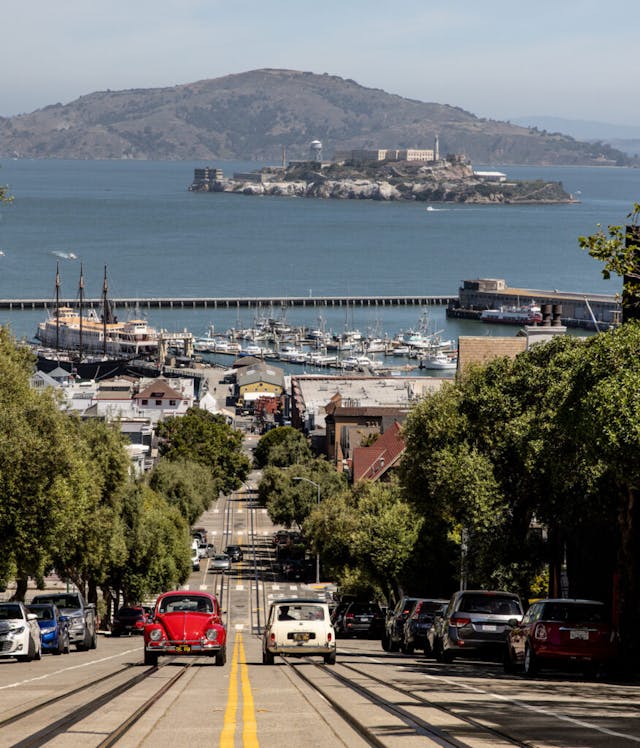
But it’s not the ’60s, it’s 2022, and compared with the Teslas and BMWs populating the city’s parking lots today, the Beetle and Mini looked like die-cast Dinky Toys. Lofgren and Van Lieu had never met, but they were already bros by association—as they would shortly discover. Meanwhile, the inimitable and plucky Mini, which debuted in 1959 and lasted in series production in three different versions—Mk I, Mk II, and Mk III—until 2000, was designed not for hippies but for the English working classes. Its cute-as-a-button looks, usefulness, and humility endeared itself to buyers who had lived through the Depression and one or both world wars. And its improbable outright victories in the Rallye Monte-Carlo in 1964, ’65, and ’67, after race-tuning by John Cooper, made it a legendary giant-killer. Which was really something for a car not drastically larger than a sow bug.
It’s funny that the lowly roly-poly bug should come up because the Mini pretty much owes its existence to one—the Volkswagen Beetle, that is. Wartime was partly responsible for both, and although we regard the Mini and the Beetle as Hippie Generation fashion statements here in America, their shared genesis was far less sunny and steeped in real need. The Volkswagen was designed before World War II, but not produced in huge volume until the ragtag remains of German manufacturing went into phoenix mode. Postwar, Great Britain owned the rights to Volkswagen production, as the Wolfsburg headquarters was in the British occupation zone. Despite chronic materials shortages, VW managed to start assembling cars in 1945, and it’s reported that, so soon after the war ended, some German soldiers appeared for work in military uniform—presumably the only clothes they owned.

Like the later Austin Mini, the Beetle was designed to do the most with the least. Its rear engine, in air-cooled opposed-four layout, allowed maximum interior space and a flat floorpan, which made the Beetle an ideal people mover. It spawned the Type 2 Transporter (aka “microbus”) in 1950, the Single Cab pickup in 1952, and the Double Cab variant in 1953. Soon, the viability of the Beetle, and its benefit to the German economy, inspired English leadership to produce a similar car on home soil. Enter Alec Issigonis, born to a British-Greek family that immigrated to England in 1923. Innovative from a young age, he became a Morris engineer at 30 and helped develop the 1948 Morris Minor, the Mini’s predecessor.
But young Issigonis’s opus was yet to come: the 1959 Mini-Minor, hurried into prototype form in 1957 thanks to fuel rationing brought about by the Suez Canal crisis of ’56. The car is a unibody box of uncommon simplicity. Four-cylinder engines from 848 cc to 1275 cc inhabited the engine bay, all turned sideways and driving through a transaxle sharing a deep iron case with the engine. The inspiration was from motorcycles, and the Mini inspired Mr. Lamborghini in creating the Miura. Despite the Mini’s formal grille, the radiator nestles between the nose of the engine and the left inner fender, with a multiblade fan pulling cooling air through the coils. The four-speed gearbox gets rowed via a steel rod and a floor-mounted, sprightly lever. Though never selling in the numbers of the Beetle, the Mini chased the same frugal customers in the U.S. from 1960, when it first appeared as the 35-hp Austin 850, until 1967, when the last 76-hp Cooper S yielded to new federal safety and emissions regulations.
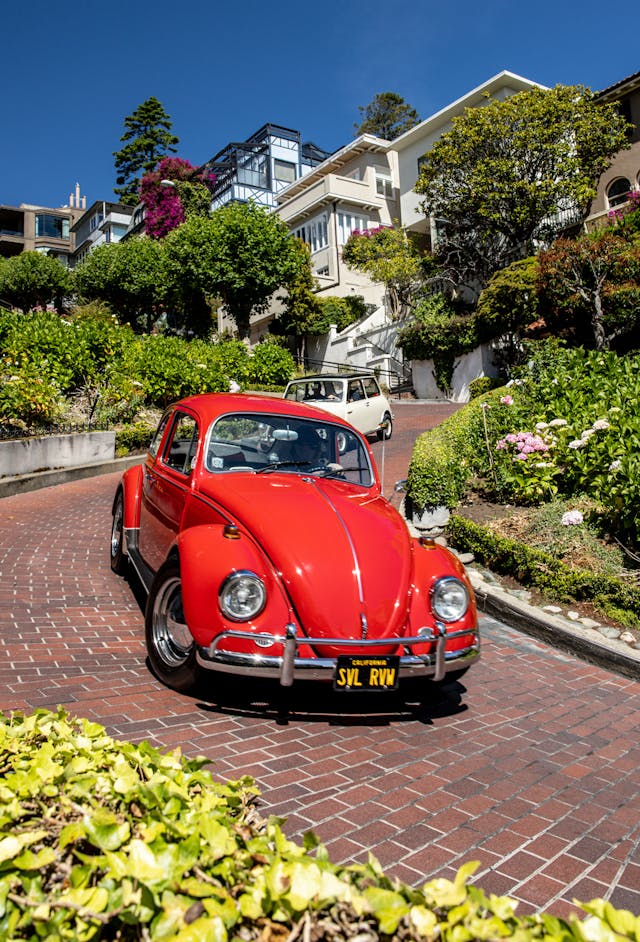
Our run first took in the Marina District and the oceanfront, rattling down crooked Lombard Street and over to Chinatown for lunch. Throughout, the Cooper S was energetic; I remember seeing them at Riverside International Raceway in SoCal in the 1960s, slinging around Turn 6 (occasionally on two wheels) and haranguing much larger production cars with the aggressiveness and wile of a rabid terrier. In the city, the big greenhouse of the Mini offers terrific visibility and the most effortless parking this side of a Vespa scooter.
In a lapse of good judgment, Van Lieu handed me the keys to his Beetle, then allowed me to slide behind the wheel for our next drive stint. Comparatively, the Beetle is a luxury car. The seats are thick and supple, the sound attenuation is way better, all gears are synchromesh, and the ride quality on its 15-inch wheels (and torsion bar suspension) is vastly better.

The experiential differences crystallized as soon as I jumped from the Austin to the Volkswagen. The Beetle is a creampuff cruiser in comparison with the Cooper S. The VW body’s insulative properties far exceed those of the Mini, and the engine and driveline noise and vibration, separated from the cabin by a back seat and a firewall, seem more like a distant drumming than an immediate, in-your-face fracas. Quite frankly, the humble Volkswagen, the most iconic “people’s car” of the 20th century, feels like a luxury sedan compared with the Mini.
Lofgren has been a car guy since childhood and owns Triumph TR4s and TR6s, a Daytona Coupe replica, a Series I Jag E-Type, and this Cooper, among others. “There was no ‘car think’ in my family until my generation, but it still started early for me,” Lofgren said. “My younger brother and I were into Hot Wheels and Matchbox cars and would drive them on the Oriental carpets, using the patterns as lanes,” he recalled. “The first car I worked on was my parents’ 1971 VW Super Beetle, and the first car of my own was the TR6—I bought one at 18 and still have it.” Lofgren holds a mechanical engineering degree from Stanford. “Most tech people have no automotive skills,” he mused. Today, with retirement in sight, he and his wife work around 25 hours a week on their collection.

Lofgren likes the ’67 Mini Cooper S because it’s the highest performance and purest expression of John Cooper’s original intent, and it features a smaller and more delicate grille and taillights than the Mk II that debuted for ’68. This particular year also has BMC’s Hydrolastic suspension, which uses two pairs (one left, one right) of hydraulic fluid–filled rubber bags—essentially, springs and dampers inventively combined as one. Hitting road irregularities pumps the fluid aft and fore, much like water is traded between locks of the Panama Canal.
Van Lieu has long been a Volkswagen man, although he didn’t start that way. “My father was a Cadillac man,” explained the Michigan native. “When I was 9, he had a ’59 model, the kind with the roof extension; it was midnight black with a white interior. He was really into that car. In 1970, my sister needed a car and bought a new VW, but it wasn’t what she wanted, so my father told me to take over the payments.” (Sherman had been driving a canary-yellow ’64 Chevelle Malibu SS with a 327, a four-speed, and black bucket seats.)
“After high school, I got into the anti-establishment period with long hair and bell-bottoms,” continued Van Lieu. “Ecology was the thing then and the Malibu was a gas-eating car, while the Bug was a social and political statement. It was not luxurious, it had a horrible heater, and the windows froze up, but it was easy to keep up—the motor drops off with four bolts. Plus, it was a ‘people’s car,’ not my father’s yacht.”
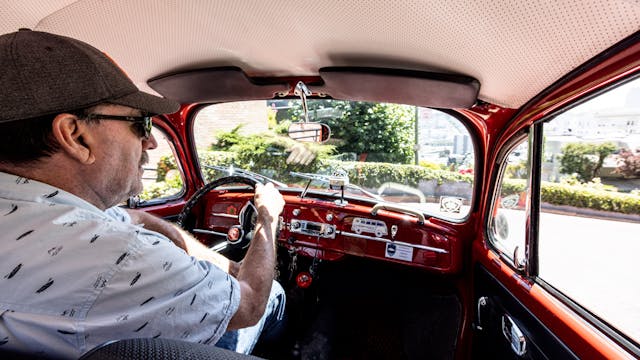
Van Lieu appreciates the ’67 model, his fifth Volkswagen in 52 years, for several reasons, including its 12-volt electrical system, the metal dashboard, low-back seats, flat windshield, small taillights, and classic chromed bumpers.
The sight of two lanky dudes (at 6-foot-2, Van Lieu similarly towers over his Beetle) and their corgi-size cars was immediately intriguing—and so was learning that for the day they’d offered us with their cars, their tastes in how to use them also matched. Lofgren, of Swedish descent and impossibly tall for the Cooper S, and Van Lieu, a retired contractor with a penchant for ’60s Beetles, were impeccably aligned. Both like the essential honesty of their cars. Both love working on and sharing them. And both wanted their day with us configured the same way—with a maximum of low-stress, scenic driving and a minimum of time doing stop-and-go in the city.
Shy of Lofgren’s stance and sporting a Pencil Neck Geek physique and size 11 hoofs, I found wriggling into the Mini manageable. And once inside, surprise! There’s a ridiculous amount of space. There is no dashboard, per se, just a compact, centrally mounted instrument panel with a speedo, temp, fuel and oil gauges, and a modest bank of switches. The steering column is even adjustable—if you have a couple of combination wrenches. Seatbelt on, pull the choke knob, and turn the key. The tuned four doesn’t just start. No, firing this motor up, inside this cabin, is an immersive experience. The resonant frequency, the hollow and uninsulated unibody, the free-flowing exhaust system, and the low-restriction intake all take you to a loud, tinny, vibrating place. It’s like an all-out race car—blip the throttle, and the body buzzes in time with the revs.
The shift knob is the size of a mouse, as is most everything else on Planet Mini, including the exterior dimensions (the 56-inch-wide, 10-foot-long Austin would squeeze into a long-bed Detroit pickup with its tailgate down), the 10-inch wheels and tires, and, inside, the pedals. The Austin has a nonsynchro first gear, and I found the gear changes required deft operation of the throttle, clutch, and gear lever to avoid unpleasant grinding. But all of this mattered not once the Mini was rolling. Right then and there, the little Cooper S turned into a raging roller scooter, accelerating hard and responding to control inputs with eye-blink rapidity.
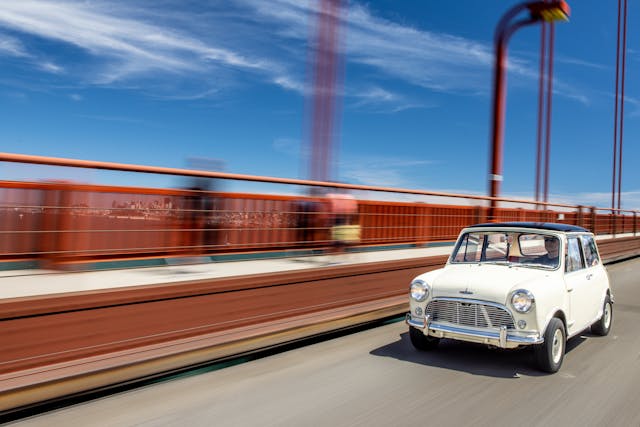
Honoring Van Lieu and Lofgren’s common interest in avoiding urban traffic, we eventually threaded our way toward the Golden Gate Bridge, arriving before the afternoon northern exodus to Marin. The cars wheeled across the famous 1.7-mile-long suspension bridge, the hellhole Alcatraz penitentiary to the right and 5100 miles of open Pacific Ocean to the left. Still marveling at the relative luxuriousness of the Volkswagen, I nearly missed the exit for the Marin Headlands. The narrow loop road here, much of it blissfully one way, wanders 12 miles atop and near the steep headlands and offers some of the most stunning views this side of Yosemite. But it’s not for foggy-headed drivers.
That’s because, after snaking upward to Fort Barry—a 1905 artillery battery built to safeguard the crucial Golden Gate—the road crests, feigns hard left, and plummets south in an alarming 18 percent grade. That’s three times steeper than any interstate and approaches the 30-degree pitch of San Francisco’s Chestnut Street and others, where Steve McQueen’s Mustang 390 GT took flight in Bullitt.
Brakes are important here. The Volkswagen front-disc conversion felt linear, predictable, and sure while threading down this serious part of our route. As well they should have, because it’s easy to imagine plowing off-road at the bottom and then sailing, Thelma & Louise style, off the edge and 400 feet down into seething, sharky waters. But this composed descent changed when we swapped rides and repeated the route, this time with me steering the Mini. “Better use second gear,” Lofgren said, seriously. “I’m not sure about the brakes. Oh, and hold the shift lever so it won’t jump out of gear.” With the engine whinnying and Lofgren looking uncomfortable in the right seat, the lovingly restored Cooper—Lofgren spent three years personally redoing everything from paint to metalwork, from engine to headliner—safely made the grade.

Following were a delicious few miles of secluded, beautifully paved, scenic, narrow and twisty road, all minutes from San Francisco. We were lucky, as the clear skies and benevolent temps we enjoyed are often redacted by petulant, clammy fog, but not today. At the photographer’s behest, finally we headed back to the Golden Gate and Horseshoe Bay, notable for its worm’s-eye view of the famous bridge soaring overhead. He wanted pictures, and I wanted context and perspective, essential for any story worth telling.
For some mysterious reason, a mere 4 miles from downtown San Francisco, the small bay and its attendant parking lot were virtually empty. So, with some daylight left and nearby quiet roads available, a precious missing piece formed, suddenly crisp and strong: The owners should trade cars!

Van Lieu, who had never driven any Mini, wedged himself inside Lofgren’s car and drove off. Upon returning, Van Lieu looked dumbfounded. “Deafening!” he exclaimed. “When it first started, the noise level was just tremendous, and I didn’t expect that much vibration. Then it was hard to find the brake and the clutch, because they’re so close together.” (Sherman wears size 11½ cowboy boots.) “The headroom was fine, but the rough ride and seating comfort were probably a little hard for me,” he concluded. “Years ago, I thought about getting one, but if they all sound like that when you’re driving, I don’t think I’d want it.” I’d sought clarity and there it was. Respect.

Next up, Lofgren hadn’t driven a Beetle in decades. “This is so civilized!” he said with a laugh. “It’s quiet and relatively smooth, not busy like the Mini. It brought back lots of memories of driving my parents’ Super Beetle when I was in high school. The steering is light and direct, and overall, this car seems better than our old one. Plus, it’s easier to drive and probably more people would feel comfortable in it than in the Mini, which is more raw than refined.”
Those 10 sentences from two owners may contain all you need to know for a potential Mini Cooper S or Beetle purchase decision. So, which is it? There’s no right or wrong answer, of course, only your own. Or, as they used to say around San Francisco, the answer, my friend, is blowin’ in the wind.
***
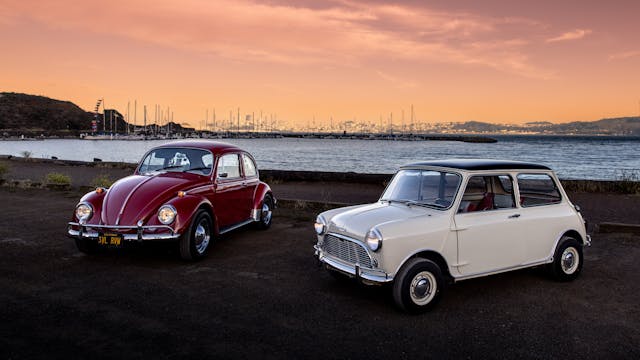
1967 Volkswagen Beetle
Engine: 1.5-liter H-4
Power: 53 hp @ 4200 rpm
Torque: 78 lb-ft @ 2600 rpm
Weight: 1700 pounds
Power-to-weight: 32.1 pound/hp
0-60 mph: 17.4 sec
Top speed: 84 mph
Price new: $1639
***
1967 Austin Mini Cooper S
Engine: 1.3-liter I-4
Power: 78 hp @ 5800 rpm
Torque: 80 lb-ft @ 3000 rpm
Weight: 1402 pounds
Power-to-weight: 18 pound/hp
0-60 mph: 11.5 sec
Top speed: 100 mph
Price new: $2341
***
Strong Sellers: Beloved by many, both the Austin Mini and Volkswagen Beetle were sold in vast quantities—5.3 million Minis were produced from 1959 to 2000, and 21 million Beetles were produced from 1946 to 2003.
Racing Credentials: With tuning help from Formula 1 constructor John Cooper, the Mini became a racing success, winning the challenging Monte Carlo Rally in 1964, 1965, and 1967.
Value Proposition: The Hagerty Price Guide #3 valuation pegs a ’67 Beetle at $21,900 and a ’67 Mini Cooper S at $33,600. Even adjusting the original MSRPs for inflation, both cars have gained significant value over the years (+51% for the Beetle, +62% for the Mini).
This article first appeared in Hagerty Drivers Club magazine. Click here to subscribe and join the club.
Check out the Hagerty Media homepage so you don’t miss a single story, or better yet, bookmark it.

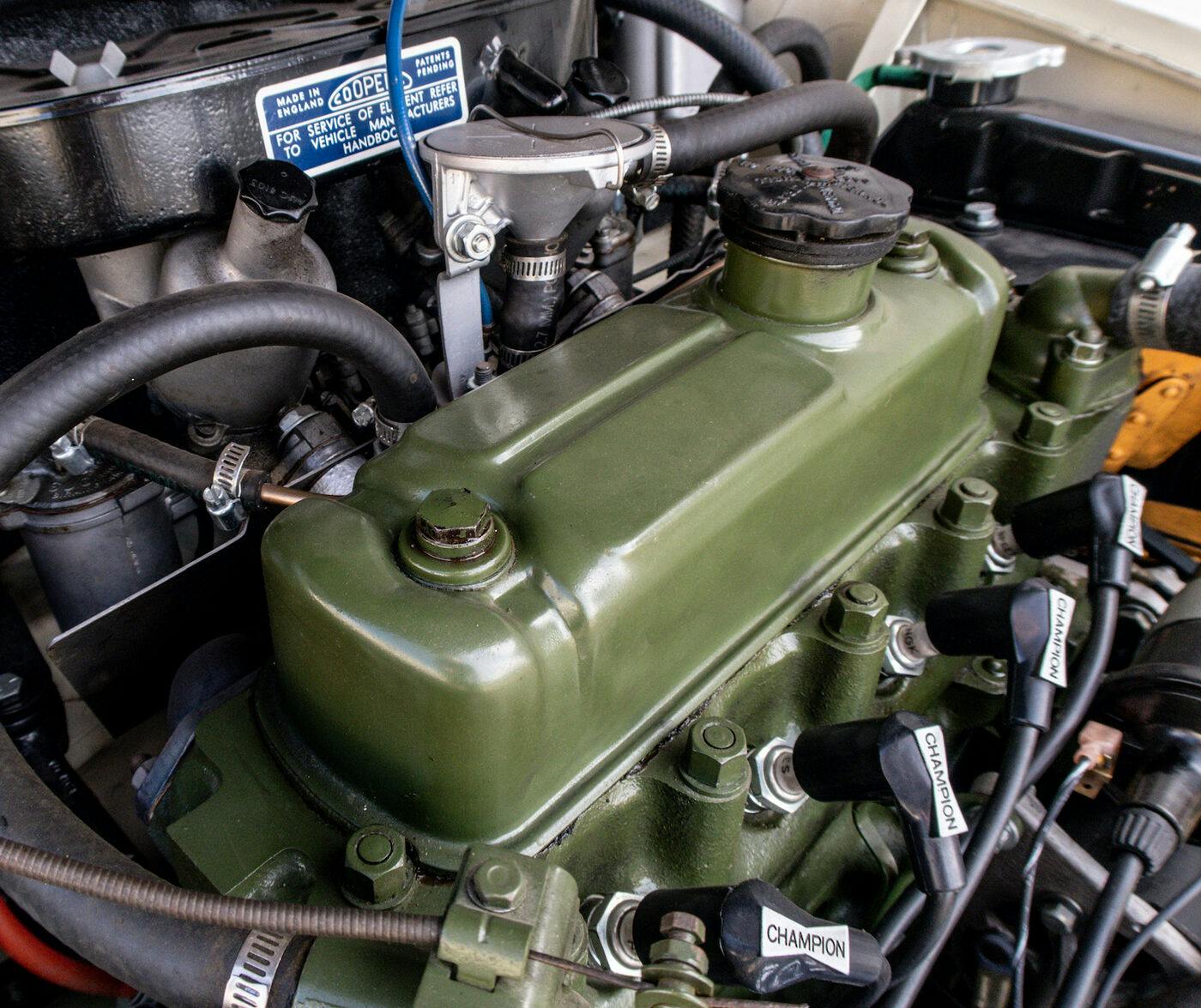



Well, since I am 6’4″ I’d have to go with the Beetle, LOL!! 🙂
Both sound fun for their own reasons. How about one of each!
I like the way you think! 🙂 For as long as I can remember I’ve had a penchant for old Volkswagens (and currently have two), but I’ve always wanted a Mini as well. Unfortunately as of yet I haven’t scratched that itch.
Fun cars. Still I feel I would feel quite cramped in one with a passenger.
VWs have an H-4 engine, not an I-4!
I’ve owned and restored many Minis. Panel vans, saloon cars, even an Innocenti Mini-t Lengo (woody wagon). I would definitely choose the Mini over the VeeDub. The way a Mini handles is just insane. It’s the closest thing to a street legal go-cart you can find!
I can relate!
I’m 6’2″ 210 lb. owner of a pair of Karmann Ghia’s. They seemed to be easier to fold in and out of back in my school days 45+ years ago.
No mention of quality-control? The VW used Bosch electrical system and Solex carb vs the Mini’s Lucas electrics (don’t get me started) and SU carb. Guess which one was more reliable? However, legacy-wise, the Mini won because virtually all hatchbacks follow the mini’s design.
Lucas electrics were equal opportunity disasters looking for a place to happen. Driving my ’68 4.2 liter E-Type roadster from Oklahoma City to Norman in 1972, during a rainstorm, at night . . . all lights and windshield wipers stopped simultaneously. Naturally, I had a generously supplied box of fuses in the car. Fortunately, I survived to stop and replace the bad one, or ones.
Small point, but the Mini’s engine fan is actually a “pusher”. Rather than pulling air through the grille and radiator, like a normal car, it actually pushes it through the radiator and out the left wheel well via a set of louvers in the inner fender. Just one of the many oddball things that make a Mini a Mini!
I currently own a 67 VW Beetle and I can relate to every line in your story. For some reason, though VW Beetles, Karmann Ghia’s and Buses are part of my driving history since I was a kid, the Mini has always been a “kindred spirit” car. Love them both!!